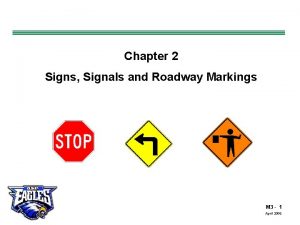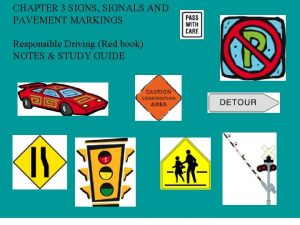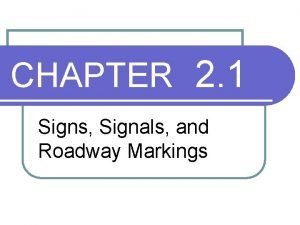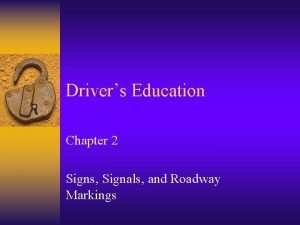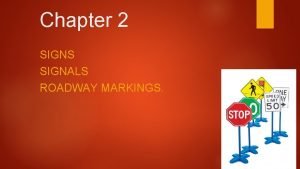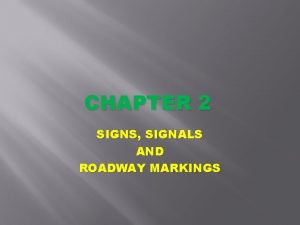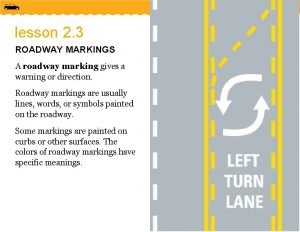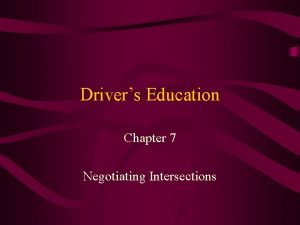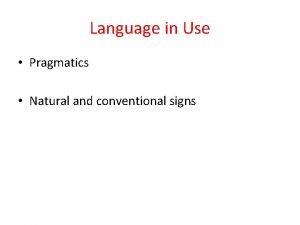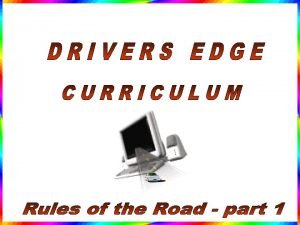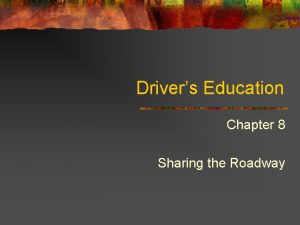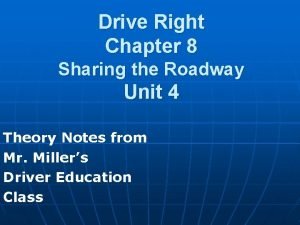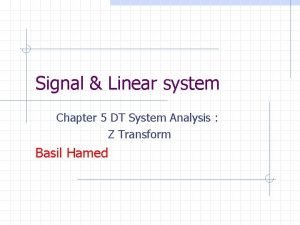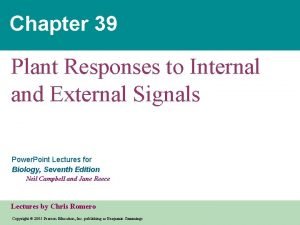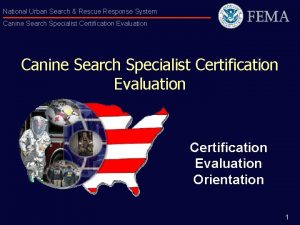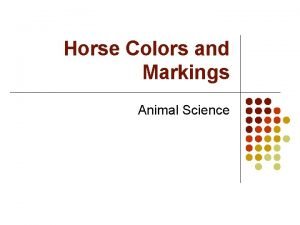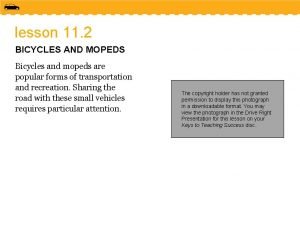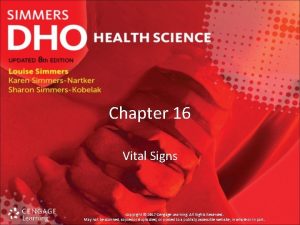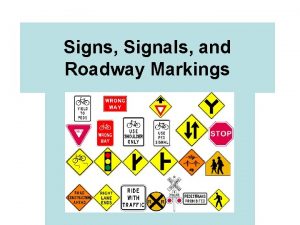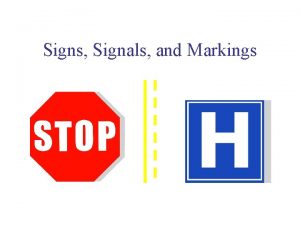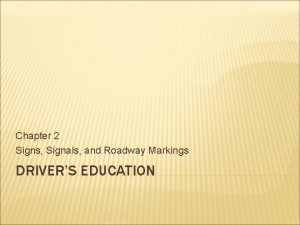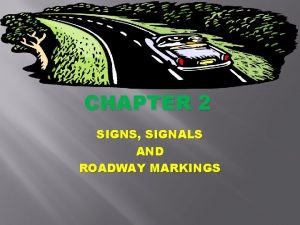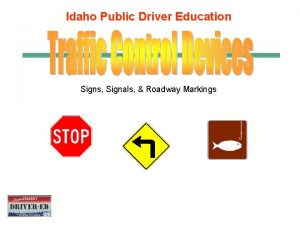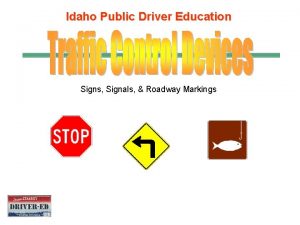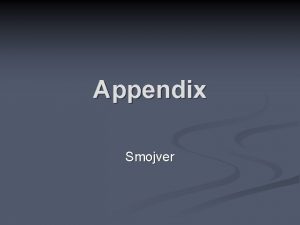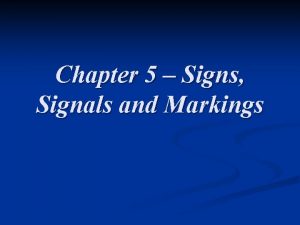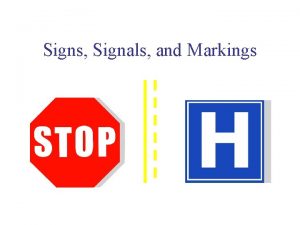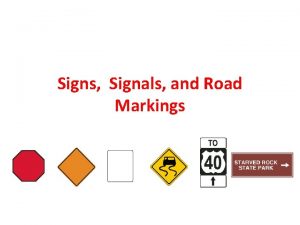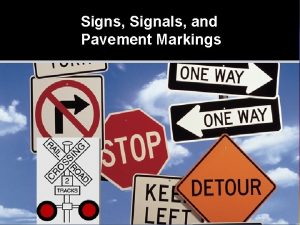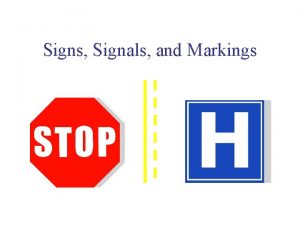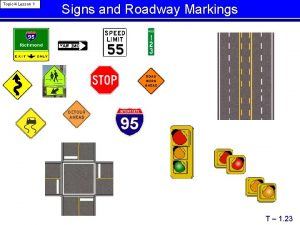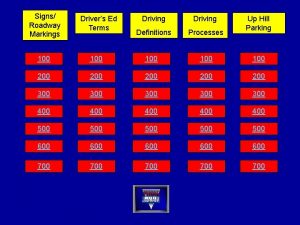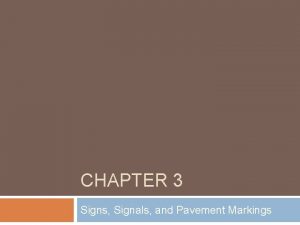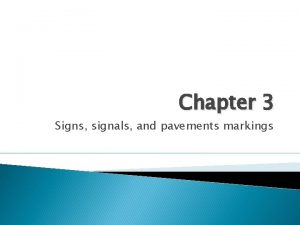Chapter 2 SIGNS SIGNALS ROADWAY MARKINGS Shapes and




























- Slides: 28

Chapter 2 SIGNS SIGNALS ROADWAY MARKINGS.

Shapes and Colors You can tell the types of signs by their shape and the color of the sign. The shapes and colors have specific meanings. There are three types of signs. Regulatory Signs Warning Signs Guide Signs What do you think are the purposes of these three types?

Regulatory Signs These are red, black, and white – they are used to control traffc. Stop Sign Must come to a complete stop, not a rolling stop. Location of the sign indicates where to stop. Stop before any crosswalks. Creep slowly ahead if your view is blocked. Yield Sign Be prepared to stop Stop if there is cross traffic that you need to yield to Remember – slow down coming to the sign, then accelerate through the intersection if it is clear. Speed Limit Sign The speed limit starts at the sign, not when you see it! Basic speed law – you cannot drive faster than is safe and prudent under the current conditions. You can get ticketed for going 55 in a 55 mph zone if conditions are not good – weather can be a reason.

Other Regulatory Signs One Way – traffic can only go in the direction the arrow on the sign is pointing. Do Not Enter No Parking No Passing

Warning Signs There are many types of warning signs – they alert you to a hazard or a change in road conditions. Yellow with a diamond shape. Narrow Road/Merging Road No Passing Zone Goes from 2 lanes to 1 lane * Pennant Shape – start and complete a pass within broken yellow lines to be legal. Law enforcement will not give a break for passing in a no passing zone.

More Warning Signs There are many warning signs Page 23 in your textbook has Many examples as well.

Railroad Signs There a couple types of railroad signs. Here are two of them below. Some will have the number of tracks posted on them. Be careful for multiple trains if multiple tracks are present. Some have flashing red lights and gates, while others just have the signs. All school buses stop at RR crossings.

Construction and Slow Moving Vehicles Construction signs are orange. Fines for speeding in construction zones are doubled, sometimes tripled. Be prepared to follow directions from workers and pilot cars. Be prepared to stop, slow down, or drive around workers and equipment. Slow-moving vehicle signs are orange triangles that are bordered in red. https: //www. youtube. com/watch? v=Mjy. Pk 9 M 7 ZWE

Guide Signs Green, blue, and brown in color. Used to mark routes, intersections, service areas, and other points of interest or information. Direction/distance signs – show direction/distance to a destination. Service Signs – blue signs that show what services are offered – gas/food/etc. Recreational – signs to parks or recreation areas.

International Signs using pictures that everyone should understand. In the US, they will help when people may not understand English well, but they will understand the picture.

Intersections The #1 cause of crashes is because people don’t know who has the right of way (who gets to go first)!!! Three types of intersections – you need to know these and who has the right of way!!! As you approach the intersection, you need to know what type of intersection you are dealing with and the rules of each type!!! Remember – left turns don’t get many breaks so pay attention to oncoming traffic because they would have the right of way if you are making a left turn!!!

3 Types of Intersections 1. Controlled Intersection 2. Uncontrolled Intersection 3. Partially Controlled Intersection

Controlled Intersections 4 -way intersection. What are the rules? Line vehicle up so the front is even with the stop sign. Stop behind any crosswalk or white line. 1 st vehicle to arrive gets to go first If two arrive at the same time – vehicle on the right has the right of way. What if 3 or 4 arrive at the same time…. Who goes first?

Uncontrolled Intersections • • • Yield to the vehicle on the right The vehicle on the left SHOULD (not will) yield to you if you are on the right It doesn’t matter who gets there first Important things to know about the car on your right 1. How fast are they going? 2. Are they turning or going straight? 3. Do they have their turn signal on? Do vehicles ever turn without signaling? Do vehicles ever signal and not turn?

Partially Controlled Intersections • As you approach this type of intersection, ask yourself – do I have a something or nothing? This means – do I have a sign or don’t I have a sign? 1. A nothing has the right of way over a something. 2. You will get cut off because you have a something and the other car will take the right of way. Be ready for that! Are there any other intersection types you want To talk about?

Traffic Lights Red – stop Yellow – prepare to stop. This does not mean speed up to get through the intersection!!! Green – go Look both ways when light turns green in case someone is running a red light.

Multi-lane Intersection with lights Label the top and bottom lanes A, B, C, and D What lane should each of these blue Cars turn into?

Right on Red How can you tell if this is legal? Look for signs that prohibit it. No sign = legal Rules 1 – come to a complete stop 2 – yield to all traffic – vehicles on your left and pedestrians 3 – When all is clear, GO – with caution. You do not have the right of way!

Flashing Signals Flashing Yellow Lights Yield to oncoming traffic before making your turn. Like a yield sign. Flashing Red Lights Treat it like a stop sign. If you have a flashing red, cross traffic has a flashing yellow.

Arrows When on a road with multiple lanes, look at the light in your lane. You might have a red in your lane (turning lane) and the driver next to you might have a green. This is called a delayed green light. * Green arrows are protected left turns. You have the right of way. Cross traffic next To you will have a red light. A normal green light is an unprotected left Turn. You have to yield to oncoming traffic Before turning left.

Entering an intersection We will have you move into the intersection to prepare for a left turn. If the light turns red while you are in the intersection, it is legal for you to complete your turn. If you are not in the intersection, you must wait for the next cycle of lights. Remember – one car at a time in the intersection to make a left turn. If the car ahead of you makes the turn and the light is still green, you may proceed into the intersection to get ready for your turn.

Pedestrian Crossings Pedestrians ALWAYS have the right of way – even if they are wrong –they’re right. Pedestrian crossings could be: 1. White light of a pedestrian crossing or the word “walk” 2. Red light of a hand that means no crossing, or the words “don’t walk” *Police officers that are in the intersection directing traffic overrule the lights. Watch them and not the lights. They will tell you when to go or stop. You will see this in Milbank during things like parades, the Cancer Walk, or Farley Fest.

Roadway Markings There are many roadway markings. Can you name what these mean and wh You as a driver are allowed to do?

Passing Ask yourself 3 questions before passing a vehicle. 1. Is it safe? 2. Is it legal? What do the yellow lines in your lane look like? If they are broken, a pass would be legal. Solid yellow lines are a no passing zone. 3. Is it worth it? Are you turning soon? Not worth it. Be Patient. As the passer, you are responsible for the pass! Did you know? You can go 10 mph over the speed limit to complete a pass – you need to know how fast the car ahead of you is going. The rule is = if the car ahead of you is within 10 mph of the posted speed limit, you should not pass.

Shared Left Turning Lanes This is on our 3 lane in Milbank. 1. Move into the shared left turning lane as close to the turn as possible. 2. You are not allowed to drive in this lane. 3. When making a left turn, you are allowed to go into the lane but you have to wait until it clears and make a lane change.

Miscellaneous Items HOV Lanes – high occupancy vehicle lanes Roads may have a special lane (Car pool lane) for vehicles with more than one occupant. Rumble Strips – on side and sometimes middle of roads to alert if you are fading to the right or center of road. Also used warn of changes in road conditions or stops ahead. Speed Bumps and Dips – to slow down speeders. Reflective Markings – to show you the edge of the road. Especially useful at night.

Sings, Signals, and Roadway Markings The video below will review what we have covered and shows the use of signs, signals, and markings while driving. https: //www. youtube. com/watch? v=Sq 73 JOh. EU 5 s

Review Chapter 2 Signs, Signals, and Roadway Markings Page 37 – vocab Page 38 – Discussion questions Page 39 – Multiple Choice Signs Practice Test http: //www. usa-traffic-signs. com/Test_s/50. htm
 Fluorescent optic yellow sign meaning
Fluorescent optic yellow sign meaning Chapter 2 signs, signals, and roadway markings
Chapter 2 signs, signals, and roadway markings Signs signals and roadway markings
Signs signals and roadway markings Guide and international signs
Guide and international signs What shape is a warning sign
What shape is a warning sign A short section of corrugated roadway that warns of hazards
A short section of corrugated roadway that warns of hazards All traffic signs and meanings
All traffic signs and meanings What are six types of special roadway markings?
What are six types of special roadway markings? 6 types of special roadway markings
6 types of special roadway markings Short sections of grooved or corrugated roadway
Short sections of grooved or corrugated roadway Communicative signals and informative signals
Communicative signals and informative signals Language
Language Communicative signals and informative signals
Communicative signals and informative signals Shapes that seem to follow no rules.
Shapes that seem to follow no rules. An uncontrolled railroad crossing usually has
An uncontrolled railroad crossing usually has What is the language in
What is the language in The diamond shape is used exclusively for _____ signs.
The diamond shape is used exclusively for _____ signs. The diamond shape is used exclusively for _____ signs
The diamond shape is used exclusively for _____ signs Chapter 8 drivers ed answers signs
Chapter 8 drivers ed answers signs Drive right chapter 8
Drive right chapter 8 Signals and systems oppenheim solutions chapter 5
Signals and systems oppenheim solutions chapter 5 Chapter 39 plant responses to internal and external signals
Chapter 39 plant responses to internal and external signals Bone surface markings
Bone surface markings Urban search and rescue markings
Urban search and rescue markings Horse colors and markings
Horse colors and markings Riders of bicycles and mopeds on a roadway
Riders of bicycles and mopeds on a roadway Tpr graphing sheet
Tpr graphing sheet Vital signs and measurements chapter 37
Vital signs and measurements chapter 37 Chapter 16:2 measuring and recording vital signs
Chapter 16:2 measuring and recording vital signs
